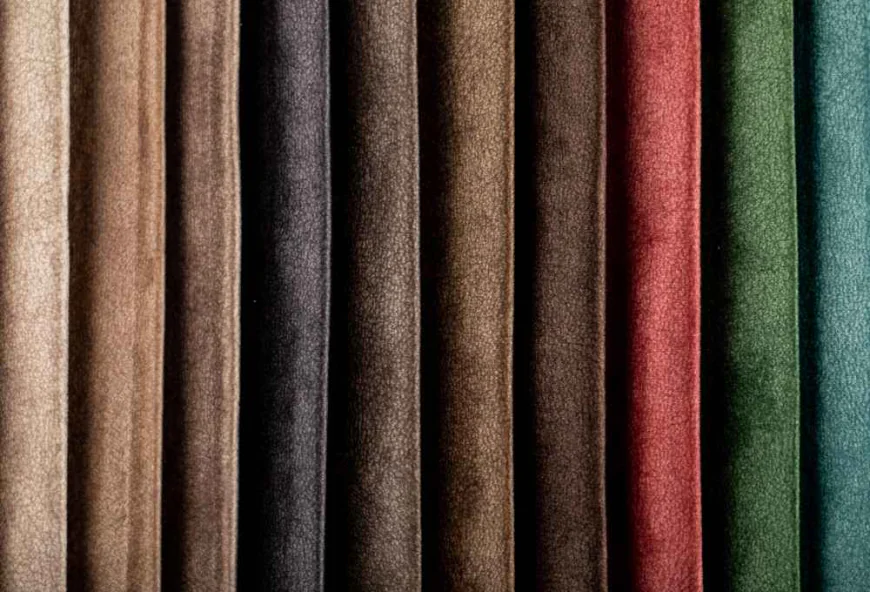How to Clean and Maintain Upholstery Fabric in UK Homes
Keeping upholstery fabric clean is one of the simplest ways to extend the life of your sofas, chairs, and cushions.

Keeping upholstery fabric clean is one of the simplest ways to extend the life of your sofas, chairs, and cushions. Because the UK climate often brings dampness, dust, and sudden spills, maintaining fabric surfaces becomes even more important. With a little routine care and the right cleaning methods, your upholstery can stay fresh, comfortable, and long-lasting. Below are practical steps any homeowner can follow.
1. Understanding the Upholstery Fabrics in UK Homes
Before you start cleaning, it helps to know what kind of fabric you are dealing with. UK homes often feature a mix of natural fibres like cotton, wool, and linen as well as synthetic blends such as polyester, acrylic, or microfiber.
Natural fibres tend to feel softer but can absorb moisture and stains more quickly. Synthetic fabrics usually resist spills better but may require gentler cleaning solutions. Always check the manufacturer’s label if available, as it usually includes recommended cleaning codes such as W, S, WS, or X.
2. Why Regular Maintenance Matters
Upholstery naturally collects dust, hair, pollen, crumbs, and oils from everyday use. Over time, this buildup affects both the look and feel of the fabric. In humid climates like the UK, moisture can also encourage mould and odours if upholstery is not looked after properly.
Regular care prevents dirt from settling deep into the fibres. It also helps you spot early signs of wear, fading, or stains before they become difficult to remove. A little maintenance each week can save you the cost of premature reupholstery or replacement.
3. Vacuuming: Your First Line of Defence
Vacuuming is the most effective way to keep upholstery fresh. Use a soft brush attachment and work gently to avoid damaging delicate fibres. Pay extra attention to corners, seams, and the space under cushions, as these areas tend to trap dirt.
If you have pets, vacuuming twice a week can make a noticeable difference. Use a handheld vacuum or a pet-specific attachment to lift hair that clings to fabric. This simple habit prevents dust and debris from embedding deeper.
4. Spot Cleaning Spills Before They Set
Accidents happen, cups get knocked over, food drops onto the sofa, or muddy boots brush against a fabric footstool. When this happens, act quickly. Blot the area gently with a clean cloth; don’t rub, as rubbing spreads the stain and pushes it further into the fibres.
For water-based stains (like juice, tea, or coffee), a small amount of mild soap mixed with warm water works well. For oil-based stains, a dry cleaning solvent suitable for upholstery is often required, especially for fabrics marked with an S cleaning code.
5. Dealing With Odours and Dampness
UK homes, especially older ones can sometimes struggle with damp air. This makes odour control an important part of fabric maintenance.
To freshen upholstery naturally, sprinkle a light layer of baking soda on the fabric, leave it for about 30 minutes, and vacuum it afterwards. Baking soda absorbs odours without damaging fibres.
If your fabric has absorbed moisture from spills or humidity, take cushions outside on a dry day or place them near good ventilation. Just avoid direct, harsh sunlight on natural fabrics, as it may cause fading over time.
6. Deep Cleaning Every Few Months
Every three to six months, it’s worth giving your upholstery a deeper clean. Steam cleaners can work well on many fabrics but must be used carefully. Too much heat or moisture can shrink fibres or leave water marks.
If the fabric has a W or WS cleaning code, you can usually use a water-based cleaner. Mix mild soap in warm water, dip a cloth into the solution, wring it well, then dab or gently wipe the surface. Always test in a hidden spot first.
For delicate fabrics, professional cleaning services may be the safest option. They have the equipment to remove dirt without damaging the material.
7. Protecting Fabric From Daily Wear
Small habits can greatly extend the life of your upholstery. Consider rotating seat cushions regularly so that one area doesn’t wear out faster than others. Throw blankets and decorative cushions aren’t just for looks; they also protect areas that get used most often.
Avoid placing fabric furniture directly beneath strong sunlight or next to heaters. Sun can fade fabric colours, while heat can weaken fibres over time.
Using fabric protectors is also an option. Always choose a spray that matches your fabric type and test it first to avoid discoloration.
8. Caring for Upholstery in Homes With Pets and Children
Homes with pets or young children often see faster wear on upholstery. To avoid constant deep cleaning, choose removable covers if possible. Washable covers make it easier to handle spills, muddy paws, or sticky fingers.
Keeping nails trimmed, providing pets with their own bedding, and training them not to jump onto certain seats can also help protect the fabric. For families, using darker shades or patterned fabrics can make everyday marks less noticeable between cleans.
9. When It’s Time to Refresh or Replace Your Fabric
Even with the best care, upholstery fabric eventually shows signs of aging. Fading, thinning, stubborn stains, or fabric that no longer feels comfortable may mean it’s time to refresh the piece.
Reupholstery is common in the UK, especially for high-quality furniture that homeowners want to preserve. When selecting new fabric, consider durability, ease of cleaning, and how well the colour suits your home’s lighting. There are many shops with a wide range of upholstery textiles, if you’re searching for reliable options, you might consider Yorkshire Fabric Shop, known in the UK for offering a variety of upholstery materials that suit modern and traditional homes alike.
Conclusion
Maintaining upholstery fabric doesn’t require professional-level skills, just consistency and simple daily habits. By vacuuming regularly, handling spills quickly, and protecting fabric surfaces from everyday wear, you can keep your furniture looking inviting for years. And when you eventually decide to refresh your fabric, shops in the UK offer many choices. For example, Yorkshire Fabric Shop provides a broad selection of upholstery fabrics and is a helpful place to explore when you’re ready to update your furniture.
FAQs
1. How often should I vacuum upholstery fabric?
Vacuuming once a week is usually enough, but homes with pets or allergies may benefit from vacuuming two to three times weekly.
2. Can I use homemade cleaners on upholstery?
Yes, mild soap mixed with warm water works for many fabrics, but always test on a hidden area first.
3. How do I remove pet hair from fabric?
Use a vacuum with a pet attachment, a lint roller, or a slightly damp rubber glove to lift hair easily.
4. Is steam cleaning safe for all fabrics?
No. Steam can damage delicate or heat-sensitive fabrics. Always check the cleaning code or consult a professional.
5. What’s the best way to prevent fading?
Keep fabric away from direct sunlight and strong artificial light. Use curtains, blinds, or UV-protective window films when needed.



 maxwell07
maxwell07 





